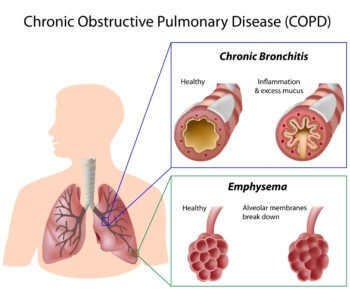COPD or Chronic Obstructive Pulmonary Disease is a disease that affects over 329,000,000 people worldwide or about 5% of the population. As of 2013, it resulted in more than 2.9 million deaths and the numbers are expected to increase, especially in the developing world.
The disease can be compounded by emphysema, which causes the destruction of lung tissue, and chronic asthma. It is exacerbated by exposure to allergens, cold air, and exercise, as well as by respiratory tract infections and exposure to environmental pollutants as is true with COPD.
Symptoms Of COPD – Basic COPD And Its Exacerbated Form
Common symptoms of COPD include:
- Shortness of breath
- Coughing, with the production of mucus or sputum
- Persistent cough that lasts three months to a year for at least two years
- Chest tightness
- Trouble walking upstairs or carrying things
Many people who have COPD have an average of three episodes each year. The disease can worsen with flare-ups, known as exacerbations of acute bronchitis. During flare-ups, the above symptoms increase and may be accompanied by:
- More labored breathing
- A fast heart rate
- Sweating
- Fast breathing
- A bluish hue to the skin
- Confusion
- Combative behavior
- Crackles in the lungs that can be detected with a stethoscope
What Causes COPD?
The number one cause of COPD is smoking cigarettes, cigars, and marijuana, which can lead to COPD among 20% of smokers and up to 50% of lifelong smokers. About 20% of cases are due to secondhand smoke; the more exposure to smoke you have, the more likely you are to get this disease. Other causes of COPD include air pollution, genetics, and occupational hazards.
Exacerbations can occur as a result of infections, improper use of certain medications, cold temperatures, exposure to environmental pollutants in the air, personal smoking, and exposure to secondhand smoke. If you suffer from COPD, you’re not only more uncomfortable during periods of acute exacerbation, but you also experience more deterioration of lung function (emphysema) and airway disease (bronchitis).
Diagnosing COPD
If you exhibit symptoms such as chronic shortness of breath, mucus production and either have a record of smoking or exposure to pollutants, your doctor may use a technique called spirometry to determine your lung function. After your doctor administers a bronchodilator, you blow into a spirometer to measure how much air you can breathe out in one second (forced expiratory volume or FEV1) and the greatest volume you can breathe out in a single breath (forced vital capacity or FVC).
The FEV1 /FVC ratio of less than 70% indicates that someone may have of COPD. The FEV number also indicates severity. In addition to using spirometry, a physician might also employ chest x-rays, blood tests, and other scans to rule out other conditions. When your symptoms deteriorate into the exacerbation stage, he may employ some of the same techniques as when he diagnosed you, but there is no universally accepted standard to define acute exacerbation of COPD.
Managing COPD With Exacerbated And Acute Bronchitis
Once you have been diagnosed with COPD, you can never completely reverse your condition, but your doctor might suggest several steps to reduce the symptoms and manage the disease. These might include:
- Stopping smoking
- Getting a yearly flu vaccine
- Getting a pneumococcal vaccine
- Exercise or pulmonary rehabilitation
- Avoiding environmental air pollution
If your COPD has reached the exacerbated stages, you may need medication such as bronchodilators to open the airways of the lungs, antibiotics to kill infection, or corticosteroids to reduce inflammation in the airways. In severe cases, you may need a brief hospitalization for oxygen and mechanical ventilation to keep your airways open.
Raintree Medical And Chiropractic Center
If you suspect that you may have any form of COPD, make an appointment with your primary care provider. Raintree Medical and Chiropractic Center can help. After evaluating your condition, your physician may recommend programs to stop smoking or exercise that can help you. For information or to schedule an appointment, call us today at 816-623-3020.

